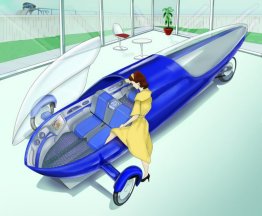
|
|
Introducing the TriTrackThe TriTrack has been in development since the first oil embargo. Most recently, it has been adapted to be a dual mode car. Dual mode means the TriTrack can be driven both on the ground and on an elevated monorail. The TriTrack is a 4-passenger electric car with additional cargo space. 
On the ground, the TriTrack is powered by a battery mule stored on the underbelly of the car. When it gets on the guideway, the battery mule drops out of the TriTrack and a linear motor built into the guideway accelerates the car to cruising speed. A smaller battery inside the car maintains its speed on the guideway and a linear generator recaptures the car's energy as it comes down off the rail. When the car reaches the ground again, it picks up a different, fully charged battery mule and continues to its final destination. SafetyConvenience Feasibility Safety has been one of the top priorities while developing the TriTrack. It is not uncommon for people to jump to the conclusion that bigger and heavier is better in terms of safety on the road, and anything less than an SUV is dangerous to drive. However, even the worst truck driver can easily avoid a vehicle traveling at 5 mph, for example. TriTrack cars are limited to slow speeds while on the ground. As the speed limit increases, the risk of a collision increases, and at some point there will be fatalities. To counter this effect, the ground speed of the TriTrack will be limited to a speed at which nobody dies. At this time in Texas, there is a law allowing 'Neighborhood Vehicles' to be street legal. A Neighborhood Vehicle is defined in part as a car that cannot go faster than 25 mph, and it is permitted to drive in areas with a posted speed limit of up to 35 mph. Initially, the TriTrack will fall under this category, and as it is more generally accepted, the maximum speed will increase to something that has been found to be non- lethal. We predict this speed to be just under 40 mph. The ground speed limit will be a real limit, not just a suggestion with random enforcement. The battery mule houses the rear wheel and motor, and the network of mules will be owned by the power company or city rather than the individual. There will be no reason for anybody to 'improve' on their mule because the first time they go anywhere, they will come home with a different mule. In addition to reduced speeds, the TriTrack car is very lightweight. Unloaded and without the battery mule, it will weigh approximately 300 lbs. Fully- loaded and on the ground it will still easily weigh less than 2000 lbs (about the same as an Indy car). What this means for safety is that if you hit a pedestrian or other car, the likelihood of injuring them is greatly reduced. The reason why we can keep the TriTrack so lightweight compared to traditional
cars is that it is built like an airplane. The strength of the structure is in
the outer honeycomb shell rather than in a heavy steel frame. Convenience is another major priority for the TriTrack. It is all well and good to design an extremely safe car, but if it is too impractical or inconvenient, then nobody will drive it and it doesn't help anything. The problem with limiting speeds is that people want to get where they're going faster, not slower. Nobody likes sitting in traffic, and who wants to add time to their daily commute? When on the guideway, the TriTrack can move at a much faster pace. The slow speeds on the ground are more than made up for when on the guideway. Ideally, from anywhere in the city, you will be no more than a half mile from the nearest guideway ramp. This ensures that the majority of your travel is on the high-speed guideway and you're not stuck in traffic on the ground.
When a car is designed to hold a full day's (or week's) worth of power, it
requires an incredibly large battery. The car's structure then must be
stronger to support it, and thus heavier. A heavy car is not as energy
efficient when it comes to moving people, and so range and performance are
dropped, and it costs more to replace the batteries. Feasibility: Finally, the solution has to be feasible. It is very important for the transportation revolution to happen as soon as possible. We've been promised flying cars and non-polluting vehicles for such a long time that people don't really believe it anymore. Everybody agrees that air pollution is a major problem, that traffic keeps getting worse, and that fossil fuels won't last much longer. A car that can solve these problems and more sounds like a dream solution that will never actually happen. The TriTrack requires no new technology to be developed. It can be built with off-the-shelf parts, using existing techniques, and because the strength is in the outer skin, it is very simple to build. This means that the unit cost will be low, even compared to traditional cars. The TriTrack dual mode, ultra- light, high-speed, monorail electric car will revolutionize both personal and shipping transportation. The last major road block is getting the guideway infrastructure built. The TriTracker is the guideway-building machine. It extrudes and rolls guideway at a rate of 3mph, and using it, a city the size of Austin could have a full network of guideways built in just a couple of months. The cost of putting in the guideway network at first seems like an impossible hurdle, but in fact TriTrack guideway is very inexpensive to build. At about $150,000 per mile, or less than 1/10th the cost of putting in highway, the guideway grid in Austin would cost only $500 million and be done in a matter of months. 1US Department of Energy |